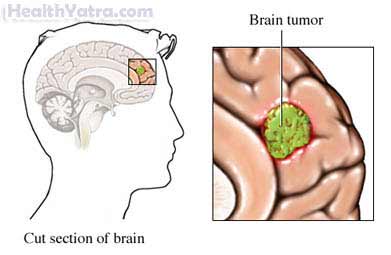परिभाषा
ए मस्तिष्क का ट्यूमर is a disease in which cells grow uncontrollably in the brain. Cancer occurs when cells in the body divide without control or order. If cells divide uncontrollably, they form a mass of tissue. The mass is called a growth or tumor. The term cancer usually refers to malignant tumors. These can invade nearby tissue and spread to other parts of the body. A benign tumor does not spread. But, it can continue to grow and press structures near it, causing symptoms.
There are two main types of brain tumors:
- Primary brain cancer—This begins in the brain. It can be either malignant or benign. A small benign tumor in a bad location can cause significant problems.
- Secondary or metastatic brain cancer—This has spread to the brain from another site in the body. All metastatic tumors are malignant.

का कारण बनता है
The cause of most primary brain cancer is unknown. The causes of secondary brain cancers are those that caused the cancer at the site of origin.
जोखिम कारक
Factors that increase your chance of developing brain tumors include:
- विकिरण
- Immune system dysfunction
- Family history of certain types of cancer
Any cancer in the body can spread to the brain. The most common tumors that may spread to the brain include:
- फेफड़े का कैंसर
- स्तन कैंसर
- Malignant melanomas
- Gastrointestinal tract cancer
- Kidney cancer
लक्षण
Symptoms depend on the tumor’s size and location. A growing tumor will often have fluid build-up around it. This is called edema. Edema puts pressure on the brain. Symptoms may develop gradually or rapidly.
लक्षणों में शामिल हो सकते हैं:
- Headache—Most headaches are not caused by brain tumors. Headaches due to brain tumors tend to have the following features:
- Worsens over a period of weeks to months
- Worse in the morning or causes you to wake during the night
- Different than a normal headache
- Worsens with change of posture, straining, or coughing
- बरामदगी
- मतली या उलटी
- Weakness in arms and/or legs
- Loss of sensation in arms and/or legs
- चलने में कठिनाई
- Hearing loss or vision loss (including double vision)
- वाणी की समस्या
- तंद्रा
- Memory problems
- व्यक्तित्व बदल जाता है
These symptoms may also be caused by other, less serious conditions. If you have any of these symptoms, see your doctor.
निदान
The doctor will ask about symptoms and medical history. A physical exam will be done. You will have a neurological exam. It will test muscle strength, coordination, reflexes, response to external actions, and alertness. The doctor may also look into your eyes to check for signs of brain swelling.
परीक्षण में शामिल हो सकते हैं:
- आपके डॉक्टर को आपके शरीर के अंदर की संरचनाओं की तस्वीरों की आवश्यकता हो सकती है। इसके साथ ऐसा किया जा सकता है:
- चुंबकीय अनुनाद इमेजिंग (एमआरआई) स्कैन
- कंप्यूटेड टोमोग्राफी (सीटी) स्कैन
- पॉज़िट्रॉन एमिशन टोमोग्राफी (पीईटी) स्कैन
- Combination PET and CT scan (PET/CT scan)
- Single-photon emission computed tomography (SPECT)
- Arteriography
- Your doctor may need to remove a sample of brain tissue for testing. This can be done with a biopsy or stereotaxis.
There are many different types of brain tumors. The doctor will classify the type. The type of brain tumor is important to determine the treatment approach.
उपचार
After cancer is found, further tests may be done if there is concern that the cancer has spread. Treatment depends on the type, size, location of the cancer, and your overall health. Treatments may leave you with physical or mental limitations.
Before beginning treatment, you may take medicines, including:
- Steroids to decrease swelling and fluid buildup
- Anticonvulsants to prevent seizures
सर्जरी
सर्जिकल प्रक्रियाओं में शामिल हैं:
- Craniotomy – opening the skull to remove the tumor or as much of the tumor as possible
- Shunt – implanting a long thin tube in the brain to divert built-up fluid to another part of the body
विकिरण चिकित्सा
Radiation therapy uses radiation to kill cancer cells and shrink tumors. This is a common treatment for brain tumors. Radiation may be:
- External radiation therapy—Radiation is directed at the tumor from a source outside the body. If you have a metastatic brain tumor, you will receive whole brain radiation therapy (WBRT). If you have a primary brain tumor, you will receive more focused radiation therapy. WRBT may also be used in people who have cancer in other areas of the body. The treatment is used to prevent brain cancer.
- Internal radiation therapy—Radioactive materials placed into the body near the cancer cells. This is used less often.
- Stereotactic radiosurgery—Higher doses can be delivered to the affected areas of the brain. Nearby normal tissue can be spared. Special equipment, including MRI and CT scans, help to focus the radiation. This is most often used in metastatic brain tumors or in benign brain tumors, such as meningiomas.
कीमोथेरपी
कीमोथेरपी is the use of drugs to kill cancer cells. It may be given in many forms, including pill, injection, or via a catheter. The drugs enter the bloodstream and travel through the body killing mostly cancer cells, but also some healthy cells. It may also be delivered directly into the cerebrospinal fluid, which bathes the brain tissue. This form of chemotherapy is called intrathecal. This is most often used when cancer has spread from elsewhere in the body to the fluid surrounding the brain and spinal cord.
Rehabilitation Therapy
Rehabilitation therapy includes:
- Physical therapy to help with walking, balance, and building strength
- Occupational therapy to help with mastering life skills, such as dressing, eating, and using the toilet
- Speech therapy to help express thoughts and overcome swallowing difficulties
रोकथाम
There are no guidelines for preventing brain cancer.

